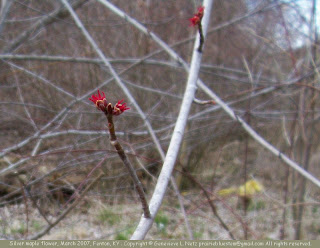Acer saccharinum, water maple, soft maple
Silver maple is one of the first trees to bloom in springtime. Its bright red blossoms are small, but they are a welcome spark of color in the landscape.
The flower buds and flowers of the silver maple are eaten by squirrels in early spring when food is scarce.
 |
| Silver maple blossoms |
In nature, the silver maple often chooses to grow in moist bottom lands or at the edges of rivers and lakes. In Kentucky it may be found growing with willows, sycamores, hackberries, cottonwoods and river birch.
The silver maple in the photo below is growing near Kentucky Lake in western Kentucky. In this location, the tree probably stands in water occasionally, but the silver maple can survive some flooding.
Silver maples are often sold in garden centers as a fast-growing shade tree. They are prone to storm damage because of their weak, brittle branches, and they are a short-lived tree that will mature at 50 to 75 years and slip into decline soon thereafter. The silver maple is well-known for clogging drains with its water-seeking roots.
Think carefully about where you want to plant this tree! We have three silver maples near our house, planted by a former owner. We've seen some severe storm damage in them several times. Fortunately -- so far! -- none of the large limbs have hit the house.
One of the trees is very large and probably at full maturity. When its health begins to decline (which will be soon,) we will be forced to remove it because of its proximity to the house.



 "The power to recognize trees at a glance without examining their leaves or flowers or fruit as they are seen, for example, from the car-window during a railroad journey, can only be acquired by studying them as they grow under all possible conditions over wide areas of territory. Such an attainment may not have much practical value, but once acquired it gives to the possessor a good deal of pleasure which is denied to less fortunate travelers."
"The power to recognize trees at a glance without examining their leaves or flowers or fruit as they are seen, for example, from the car-window during a railroad journey, can only be acquired by studying them as they grow under all possible conditions over wide areas of territory. Such an attainment may not have much practical value, but once acquired it gives to the possessor a good deal of pleasure which is denied to less fortunate travelers."
0 comments -- please add yours:
Post a Comment